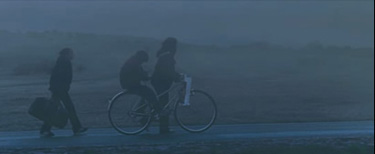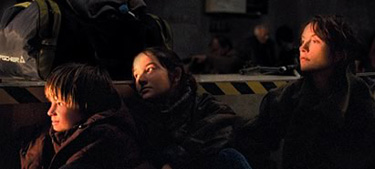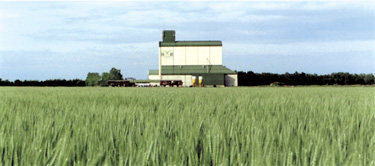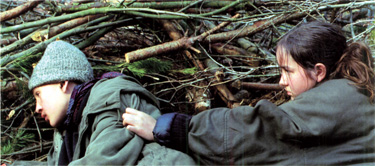Time of the Wolf
After leaving the city to go to their summer cabin a French family of four discovers a distressed family already at their place, armed with a rifle and in a near hysteric need for supplies. The intruders seem more desperate than crazy but just when attempts to placate them seem to be successful the gunman unexpectedly guns down the French husband.
This event sets the newly widowed Anne (Isabella Huppert) and her two children Eva (Anaïs Demoustier) and Ben (Lucas Biscombe) adrift in the French countryside. A mysterious catastrophe in France-if not the world-seems to have occurred, stifling the flow of supplies to urban centers and d ispersing the population out of cities. Though the film suggests that many others are sharing the same fate, Anna’s small family is dwarfed by the oppressively empty, foggy landscape making them feel isolated even if they are not. Forced into the forbidding countryside to fend for themselves the family turns back to the town for help. But finding the villages shut up and the occasional inhabitants unforgiving or unresponsive,the family goes back to roving the empty land for shelter, food, and hoping for some definitive, God-like event to save them from their seemingly intangible fate.
ispersing the population out of cities. Though the film suggests that many others are sharing the same fate, Anna’s small family is dwarfed by the oppressively empty, foggy landscape making them feel isolated even if they are not. Forced into the forbidding countryside to fend for themselves the family turns back to the town for help. But finding the villages shut up and the occasional inhabitants unforgiving or unresponsive,the family goes back to roving the empty land for shelter, food, and hoping for some definitive, God-like event to save them from their seemingly intangible fate.
A passing train provides brief hope for Anne and the children, but when it fails to stop for the screaming family they follow the tracks and find a small group of people holed up in a station, waiting for salvation from a train that may neither stop nor even pass them by. Within the group is a vague semblance of societal relations, with the requisite enforced rules and subsequent fits of conflict, frustration, hysteria, and resignation involved. 14-year old Eva attempts to befriend a roving teenage boy (Hakim Teleb), trying both to find a friend amongst the selfish adults as well as compassionately trying to draw the boy back to society. The group gradua lly allows itself to fall into a rhythm of daily life despite the arbitrariness of its survival, which remains in constant flux as they deal with lack of supplies, group conflict, inner turmoil, and the abstract dread that pervades the world around them.
lly allows itself to fall into a rhythm of daily life despite the arbitrariness of its survival, which remains in constant flux as they deal with lack of supplies, group conflict, inner turmoil, and the abstract dread that pervades the world around them.
The spare, unexplained post-civilization France of Michael Haneke’s Time of the Wolf is one that serves no direct allegorical purpose. Instead, the push and pull of the ambiguous situation, oscillating between misanthropy and humanism, glides along in an evocative, precise enactment of the tensions of a nondescript family taken far out of context.
The easy irony of Haneke’s film is that much of the pain the family suffers is a common one. It is within this reading that the film bares strong similarity to Stanley Kubirck’s 1980 film The Shining, which plopped an average family into a isolated vacuum surrounded from without and within by the burdens of myth and history. The terror-drama that thereafter played out was one that simply extrapolated from the family’s malignant inner disorder and manifesting through the environmental motivations of the “haunted” surroundings. Anne’s family is much the same way, the post-apocalyptic landscape serving merely as a literalization of the tumultuous problems within her discentered family.
All three remaining members of the family have difficulty communicating and reconnecting with each other, an alienation only underlined by the vacuous grey countryside through which they search and cold concrete interior of the train station that soon becomes their home. Anne, with her husband gone, has a crash course in single-motherhood, teetering on the bring of hysteria trying to deal with her dual responsibilities for familial survival and providing nurturing comfort and love.
10-year old Ben hams up after his father’s death and acquires the reticent mystery that all boys that age seem to have when they are moody and silent. Like Danny in The Shining he also acquires an element of the supernatural-after his father’s death Ben has emphatic nosebleeds that occur when the boy reaches a level of understanding of the wretched situation of his family.
The daughter’s path through the countryside is the most touching, not the least because of Demoustier’s curious, compassiona te face and Eva's blossoming social maturity and responsibility. The teen's attempts at getting to the runaway youth are moments of the film’s purest kindness, especially in light of an understated theme of latent racism within the multicultural European populace. The teenage couple's quarreling speaks textually for the repressed tension that generally remains unspoken between the isolated adults of the film, showing both their best and worst sides, the means for fixing the problems and the problems themselves.
te face and Eva's blossoming social maturity and responsibility. The teen's attempts at getting to the runaway youth are moments of the film’s purest kindness, especially in light of an understated theme of latent racism within the multicultural European populace. The teenage couple's quarreling speaks textually for the repressed tension that generally remains unspoken between the isolated adults of the film, showing both their best and worst sides, the means for fixing the problems and the problems themselves.
Although the family is wrestling with common issues, with the help of chilling photography by Jürgen Jürges Time of the Wolf presents a layer of latent primality to the scenario that mystifies the tale in a similar, though more "believable" way as The Shining. It is this mystery that helps individualize the normalcy of the family, making their tale at once ordinary and highly specialized. Often Haneke evokes the idea of the family as an opaque blade trying desperately to cut its through the densest haze, a disturbing metaphor both for the generic family and any extrapolations of the film's premise to Europe or humanity itself.
What stands out most strongly in the haze, stronger really than any of the human elements
in the story, is the vibrant, primal attraction of fire. Fire is used to find the lost and wandering, as well as attracting scavengers to its promising glow. Whether sparks or bonfires, the flames of Time of the Wolf seem hopeful, as if a promise of refuge, communication and social continuation. At the same time fire is infused with the powers of rebirth. Refugees stuck at the station speak of a binary paganism, where belief resides in a group called the Just, which, acco rding to belief, are either a group of copulating mystics who prolong humanity or a group of martyrs who sacrifice themselves in bonfires for the salvation of others. Though most are unbelieving, the eerily life of the fires, which provide the only vibrancy and enduring image in the whole picture, seem to contain a power which speaks for the hope inside these people. The few flames ignited seem to speak for a deep, scattered understanding of the human condition that can gradually be felt pulsating through the characters despite their often callous behavior. In them, through the flames, can be felt the power of humanity, and in that comes the power to overcome Haneke's so-called time of the wolf.
rding to belief, are either a group of copulating mystics who prolong humanity or a group of martyrs who sacrifice themselves in bonfires for the salvation of others. Though most are unbelieving, the eerily life of the fires, which provide the only vibrancy and enduring image in the whole picture, seem to contain a power which speaks for the hope inside these people. The few flames ignited seem to speak for a deep, scattered understanding of the human condition that can gradually be felt pulsating through the characters despite their often callous behavior. In them, through the flames, can be felt the power of humanity, and in that comes the power to overcome Haneke's so-called time of the wolf.


1 Comments:
This is a great post thankks
Post a Comment
Subscribe to Post Comments [Atom]
<< Home